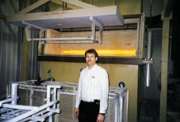Stripping Paint Line Fixutres at Amana
Amana Appliances keeps its fixtures and the environment clean...
Amana Appliances, Amana Colonies, Iowa, is one of the leading manufacturers of microwave ovens, refrigerators and other high-end appliances. Since its founding in the 1930s, the company has followed a never-ending desire to operate a strict, environmentally friendly production facility.
During the depression, quality iceboxes were needed to preserve food produced by the community of immigrants in this remote Iowa location. The people understood the benefits of letting each individual do what he or she could do best, such as preparing food, working in the field or building the community. Some raised livestock, others built homes and other buildings and certainly some fabricated metal. From this pool of talent, Amana Appliances was created.
Featured Content
Amana produced iceboxes until electric refrigerators were introduced in the mid-30s and early 40s. Microwave ovens were added during the 1970s. Today, Amana Appliances fabricates some 3,200 units daily, starting with raw steel in roll form. In the shearing, bending and stamping processes, this metal requires the application of lubricating oils. These oils are removed in an eight-stage metal treatment system. Then, the shaped metal is coated with a high-solids paint.
In this finishing process, management looked for ways to reduce energy consumption and lower waste disposal costs. The painting fixture stripping system became a prime target.
Several options were considered, including expensive repair on the existing equipment. Outsourcing this task was also an option; however, that would have required several additional sets of painting fixtures. Thus, the best option appeared to be the installation of a completely new system with specific capabilities.
First, it would need to be compatible with the environment and be able to strip high-solids paint. Second, it should reduce waste disposal. Speed was also a consideration, but not that important in the preliminary search for a suitable new system.
With these basic requirements in mind, Dale Blaha, Amana's process engineer, set out to find an optimum process for stripping organic material off carbon steel fixtures. Chemicals, shot blasting, cryogenics and other processes were evaluated. But, some had excessive operating costs and others simply could not do the job with complete worker safety. Finally, Mr. Blaha narrowed the field down to fluidized bed stripping and burn-off ovens.
Although not important initially, cycle time became a major consideration. If burn-off was used, several sets of painting fixtures would be needed. Economically, this was not a practical solution. Finally, the most cost-effective choice was fluidized bed stripping and the Seghers FluidClean system was selected. According to Mr. Blaha, "Seghers engineers have designed the system specifically for this purpose." The system has been proven in more than 400 worldwide installations, including plants operated by Caterpillar, Chrysler, Ford and DuPont. "We also like the system," Mr. Blaha continued, "because it uses the energy in the paint being removed as fuel source.
Mr. Blaha also found that the short cycle time eliminated the need to purchase additional fixtures. Fixtures are easily removed from the paint line, placed in a basket and cycled clean in 30 to 60 min. Additionally, the fluidized bed system has an afterburner for virtual total destruction of VOCs.
"Amana has significantly reduced its air emissions and hazardous waste. We figure the system will justify its initial cost in less than 18 months," Mr. Blaha noted.
RELATED CONTENT
-
Coating Thickness Measurement: The Fundamentals
A review of available test methods, common applications and innovative instrumentation...
-
Paint Application Methods
An overview of spraying, dipping, flow coating, and everything in between.
-
Painting Over Powder Coating
How safely can they apply their wet paint over our powder coated parts?




















